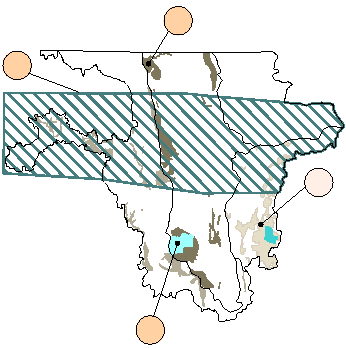Table of contents || Previous section || Next section || Glossary || PDF document
 |
Five major water-quality characteristics were evaluated for ground-water
studies in each NAWQA Study Unit. Ground-water resources were divided into two
categories:(1) drinking-water aquifers, and (2) shallow ground water
underlying agricultural or urban areas. Summary scores were computed for each
characteristic for all aquifers and shallow ground-water areas that had
adequate data. Scores for each aquifer and shallow ground-water area in the
Red River of the North Basin were compared with scores for all aquifers and
shallow ground-water areas sampled in the 20 NAWQA Study Units during 1992-95.
Results are summarized by percentiles; higher percentile values generally
indicate poorer quality compared with other NAWQA ground-water studies.
Water-quality conditions for each drinking-water aquifer also are compared to
established drinking-water standards and criteria for protection of human
health. (Methods used to compute rankings and evaluate standards and criteria
are described by Gilliom and others, in press.)
|
| RADON | |
|---|---|
 |
All radon concentrations ranked in the lower 50 percent of the samples collected from other NAWQA Study Units. Currently (1998), there are no Federal drinking-water standards for radon. The historical standard was exceeded in two-thirds and one-half of the samples collected from the surficial and buried aquifers, respectively.
|
| NITRATE | |
 |
Although nitrate concentrations generally were low in comparison to other Study Units, the variability of nitrate concentrations was high. This explains why 27, 8, and 6 percent of the samples from the western and southeastern surficial aquifers and the buried aquifers, respectively, exceeded the USEPA drinking-water standard, whereas a much larger percentage of samples from these aquifers had concentrations close to or below detection limits. Nitrate concentrations in shallow ground water of the Otter Tail Outwash agricultural area ranked in the upper 50 percent among other Study Units.
|
| DISSOLVED SOLIDS | |
 |
Dissolved-solids concentrations ranked in the upper 50 percent of the samples collected from other NAWQA Study Units. These concentrations were highest in the surficial aquifers located in the western and central subregions and in the buried aquifers sampled. These dissolved-solids concentrations, which largely reflect geology and semiarid climate, exceeded the drinking-water standard in more than one-third of the ground water sampled basin wide and from 14 to 17 percent of the shallow ground water sampled in the two agricultural areas studied.
|
| VOLATILE ORGANIC COMPOUNDS (VOCs) | |
 |
Of the two areas studied, VOCs were detected in only one well (Sheyenne Delta agricultural area), placing the Study Unit among the lowest compared to other NAWQA Study Units for VOC detections.
|
| PESTICIDES | |
 |
The number and concentrations of pesticides (mostly atrazine and related herbicides and bentazon ) were relatively low with the exception of shallow ground water in the Otter Tail outwash area. Although no drinking-water standard was exceeded in the Otter Tail study, pesticide detections ranked among the highest in detections compared to other NAWQA Study Units (highest quartile).
|